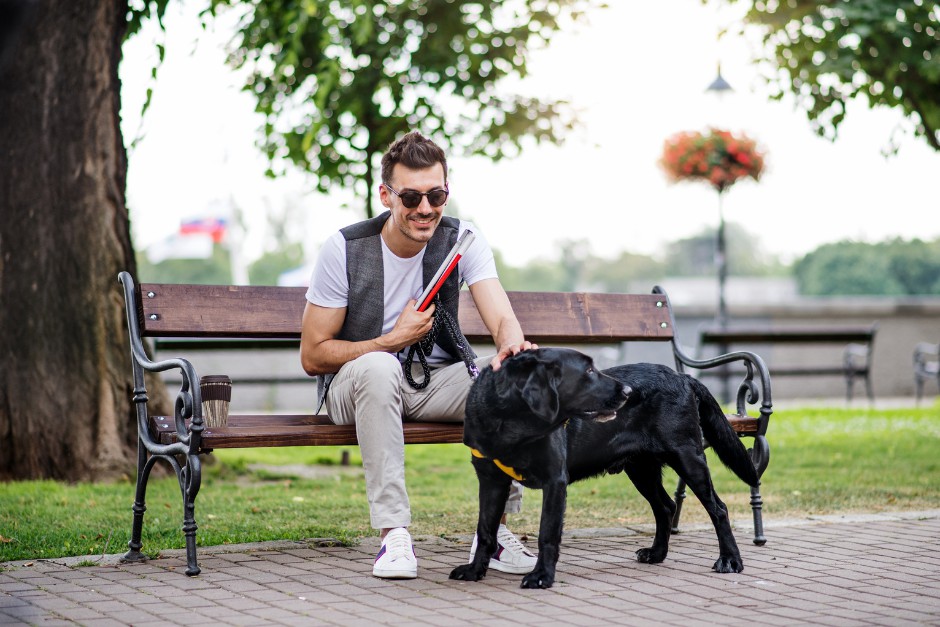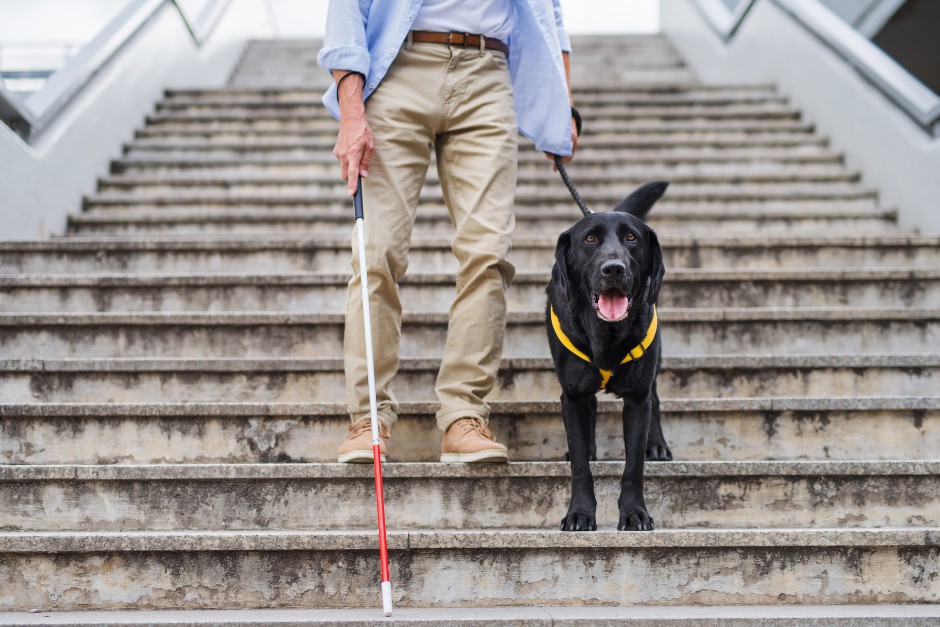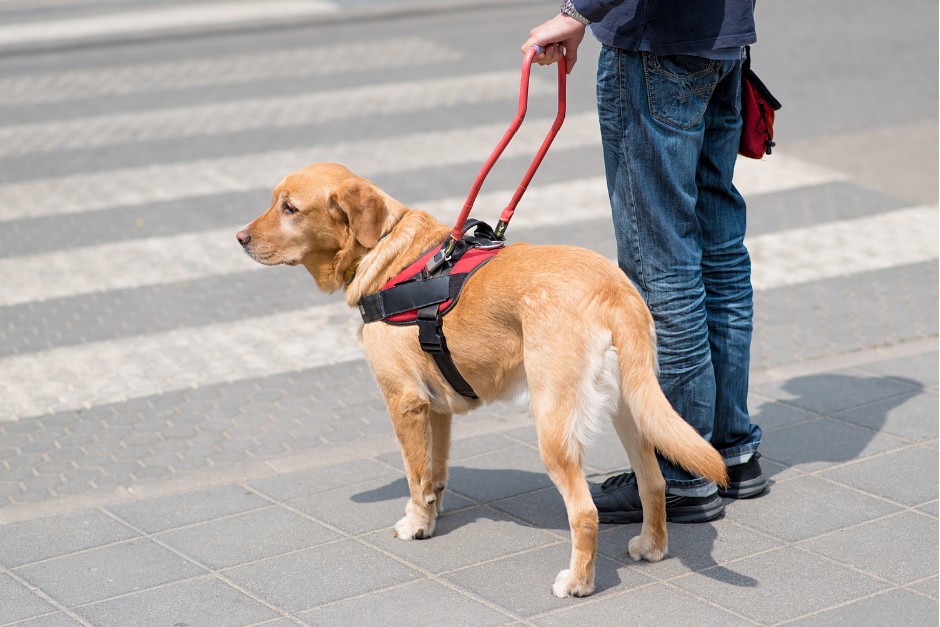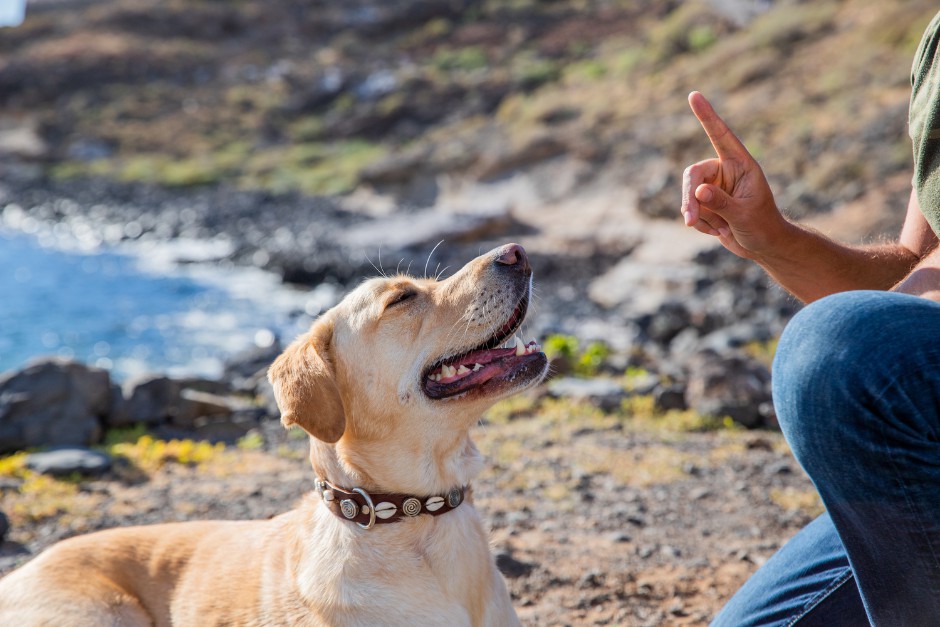Living with vision loss of any kind brings with it unique challenges, and for many people with low vision this can mean having to rely on others for many daily tasks. This can be a problem in itself, dealing with vision issues and losing a sense of independence, even feeling like a burden to others, can all contribute to a number of problems that those with 20/200 vision have to deal with.
Choosing the Right Guide Dog
You may think that every guide dog is a Labrador Retriever, they tend to be the breed we immediately think of, however this is not the case. Golden Retrievers are also commonly used as a guide dog, as well as Golden/Labrador cross breeds too, with German Shepherds, Border Collies and Vizslas also used frequently. In addition, Standard Poodles can be trained as guide dogs too, specifically for the fact they are a hypoallergenic breed that can be used by anyone, even those who suffer allergies when around other dogs.
 Guide dogs are chosen due to some specific behavioral traits that they need to be good at the job they are intended for. A guide dog for the visually impaired has to have the right temperament and the ability to learn, more than the need to be a specific breed. To be a great guide dog, they should not be easily distracted, take training easily and don’t get overexcited.
Guide dogs are chosen due to some specific behavioral traits that they need to be good at the job they are intended for. A guide dog for the visually impaired has to have the right temperament and the ability to learn, more than the need to be a specific breed. To be a great guide dog, they should not be easily distracted, take training easily and don’t get overexcited.
When properly trained, all the breeds mentioned can provide the support that someone with low vision needs, but choosing the right breed still matters. Think about the size of each breed, and how it will fit into your home and life. German Shepherds make great companions for instance, but they are large dogs that need plenty of space. But size matters in another way too, the dog has to be able to guide you around, so it needs to be big enough to be able to help you. If you are a taller or heavier person, you may need to choose a larger dog so that it has the physicality to guide you in the right direction or stop you if needed. It’s a similar story if your lifestyle means your guide dog will be required to help you in crowded environments regularly. A larger dog may fair better here, but other situations may mean a smaller dog is more suitable, so think about what you do each day when deciding.
Shedding can also be an issue, low shedding options like a Labrador and Poodle mix, often called a Labradoodle, can be a really useful option if you are concerned about a dog shedding its coat and requiring a lot of cleaning up.
Applicable Low Vision Scenarios
If you have 20/200 vision, guide dog services may be exactly what you need. Each dog is trained to provide the help you need, regardless of your eye condition, with trained dogs helping people with:
- Central vision loss
- Peripheral vision impairment
- Tunnel vision
- Any other type of vision loss
 While each of these conditions affects the individual in different ways, guide dog training means they can help in all cases. Guide dog services vary depending on individual needs, but in general they are trained to control an area twice as wide and around three times as high as a dog would usually need. This provides the space for a person to be safe, ensuring the dog protects them from potential dangers. Whether the individual needs help with objects in their peripheral vision or central vision, the guide dog will help them avoid it.
While each of these conditions affects the individual in different ways, guide dog training means they can help in all cases. Guide dog services vary depending on individual needs, but in general they are trained to control an area twice as wide and around three times as high as a dog would usually need. This provides the space for a person to be safe, ensuring the dog protects them from potential dangers. Whether the individual needs help with objects in their peripheral vision or central vision, the guide dog will help them avoid it.
Training enables the dogs to guide their owner around any potential obstacle, with the solid harness allowing the dog to choose the path for their owner, but the dogs can do more too. They can take simple commands such as ‘find a chair’ when they need somewhere to sit and have specialized training for road crossing scenarios. Guide dog services can be tailored for specific needs too, so owners enjoy the best companion and support possible.
While the dogs can provide essential self-reliance and confidence and a new level of mobility, they can’t help with reading signs and other low vision challenges. Small and portable products such as the Luna 6 video magnifier are the perfect accompaniment to your guide dog, ensuring that you can have confidence when out and about, whether finding your way through a busy mall or sitting down in a restaurant.

Resources for Applying Guide Dog Services
The key to enjoying the best experience with a guide dog for the visually impaired is to work with a reputable provider. There are a number across the United States, including:
- Guide Dogs of America
- Guide Dog Foundation
- Guide Dogs for the Blind
- Southeastern Guide Dogs
- There are also a number of regional organizations that serve states and cities. You can find a regularly updated list of local guide dog services and resources maintained by the American Council of the Blind.
As you may expect, guide dogs are not just handed over to anyone who asks for one. There are strict eligibility criteria and a lengthy application process. This is to ensure that guide dog services are suitable for each individual, and of course that the dogs are well cared for and provided with a nurturing environment.
The application process is relatively simple, although it can take a while, but first is the eligibility criteria. Each organization has their own rules, but in general, you would be eligible for a guide dog if:
- You are legally blind, with 20/200 vision or worse
- You are aged 18 years old or more
- You can physically walk one or two miles a day to provide the exercise the dog needs
- You have completed mobility training
- You can demonstrate that you are financially able to care for a guide dog
If you meet those criteria, you can apply for guide dog services from your chosen organization. This includes a form that requires you to answer questions on your personal and family situation, housing information to assess whether it is suitable for a dog, and experience with guide dogs previously, your financial ability to care for the dog and the kind of conditions the dog will be working. Essentially, they want to understand your life so that they can assess whether it is the right environment to place a dog, and that the dog can be a help to you. Or if you’re interested in more guide dog resources in different countries, don’t hesitate to talk to your local government or organizations.
 You will also be required to submit a report from your physician, eye doctor and often a mobility specialist too. After that you may be required to undertake an interview either in person or over the phone, and then all of this information will be assessed by the selection team.
You will also be required to submit a report from your physician, eye doctor and often a mobility specialist too. After that you may be required to undertake an interview either in person or over the phone, and then all of this information will be assessed by the selection team.
If you are successful, you will be matched with a suitable dog, and then attend several weeks of training so that you can get used to the dog, and the dog to you, and understand how the dog can help, and how to care for your new companion. From start to finish it can take several months to apply for and receive a guide dog, however because of the importance of ensuring each dog’s welfare, this process is crucial for the operation of the various organizations.
The demand and availability of guide dogs varies by region and country, so the number of people who apply for and are successfully awarded a guide dog each year varies greatly. It usually takes a year or more from application to completion of guide dog training. But life will always go on, so it is necessary to learn more about assistive technology and try more vision aid products. Because the use of these products allows people to maintain learning, live independently, gain confidence, and integrate into the community. These are crucial to the physical and mental development of visually impaired people.
Guide dog services can be transformational for anyone with vision loss, but the dog’s wellbeing must always come first. That is why it is so important to answer honestly and openly during the application process. Guide dog organizations want you to have the best experience possible, but also want the dog to have a caring, safe environment too. Take the application seriously, a guide dog is a big responsibility, and be patient, and your key to independence could be closer than you think.
References:
https://www.guidedogsofamerica.org/admissions/
https://www.guidedog.org/gd/get-a-guide-dog/gd/dog-programs/get-a-guide-dog.aspx
https://www.perkins.org/woof-9-interesting-and-surprising-facts-about-guide-dogs/

